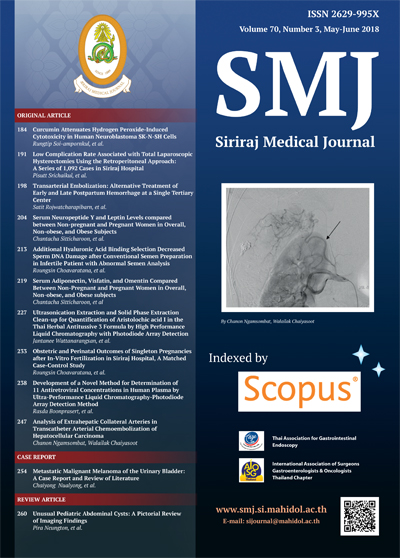Serum Adiponectin, Visfatin, and Omentin Compared between Non-pregnant and Pregnant Women in Overall, Non-obese, and Obese subjects
Keywords:
Adiponectin; insulin resistance; omentin; pregnancy; visfatinAbstract
Objective: This study aimed to compare serum adiponectin, visfatin, and omentin between non-pregnant and pregnant women in overall, non-obese, and obese subjects.
Methods: There were 40 pregnant and 33 non-pregnant women classified by body mass index (BMI) into non-obese or obese subjects. Fasting blood samples were collected in the morning for the non-pregnant group and before delivery for the pregnant group.
Results: Plasma glucose levels were significantly lower, but plasma insulin levels were significantly higher in pregnant when compared to non-pregnant women in overall, non-obese, and obese women (p<0.05 all). The homeostasis model assessment of insulin resistance (HOMA-IR) was significantly higher, but the quantitative insulin sensitivity check index (QUICKI) was significantly lower only in obese pregnant when compared to obese non-pregnant women (p<0.01 all). However, in non-obese women, HOMA-IR and QUICKI were comparable between pregnant and non-pregnant women. Serum adiponectin, visfatin, and omentin were significantly lower in pregnant compared to non-pregnant women in overall, non-obese, and obese groups (p<0.05 all). In pregnant women, serum adiponectin and omentin levels were significantly lower in obese compared to non-obese pregnant women while serum visfatin levels were comparable in both groups. Serum adiponectin levels were highest followed by omentin and visfatin, respectively in both non-obese and obese pregnant groups. These results indicated that lower serum adiponectin, visfatin, and omentin in pregnant women might contribute to higher insulin resistance in pregnancy. Furthermore, serum adiponectin and omentin were reduced in increasing adiposity similarly to non-pregnant women.
Conclusion: Lower serum adiponectin, visfatin, and omentin in pregnant women might lead to decreased insulin sensitivity in these women.
Downloads
Published
How to Cite
Issue
Section
License
Authors who publish with this journal agree to the following conditions:
Copyright Transfer
In submitting a manuscript, the authors acknowledge that the work will become the copyrighted property of Siriraj Medical Journal upon publication.
License
Articles are licensed under a Creative Commons Attribution-NonCommercial-NoDerivatives 4.0 International License (CC BY-NC-ND 4.0). This license allows for the sharing of the work for non-commercial purposes with proper attribution to the authors and the journal. However, it does not permit modifications or the creation of derivative works.
Sharing and Access
Authors are encouraged to share their article on their personal or institutional websites and through other non-commercial platforms. Doing so can increase readership and citations.











